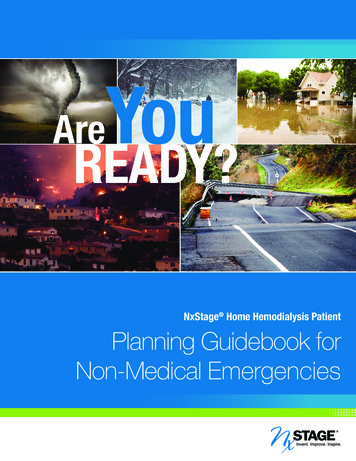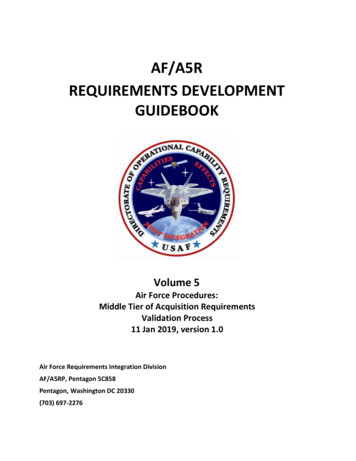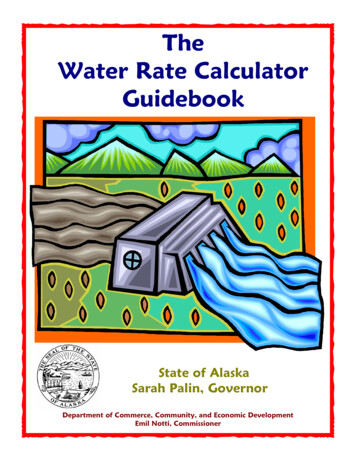
Transcription
YouAreREADY?NxStage Home Hemodialysis PatientPlanning Guidebook forNon-Medical Emergencies
Emergency Preparedness OverviewFor kidney patients, emergency preparation is essential!As a home dialysis patient, you need to be prepared for a possible emergency. Television orradio can give you advance warning about a major storm coming. But other emergencies canhappen without warning. As a home dialysis patient, you need to have power, water, suppliesand transportation. Without these, your life can be in danger.Planning ahead is your best defense in an emergency situation. In an emergency, you need toact quickly to stay out of harm’s way. This is easier to do when you have an emergency plan.Knowing who you should call, where you would go, how you would get there, and what to takewith you if you have to evacuate are important details you should plan BEFORE an emergencystrikes.NxStage has created this guidebook to help you prepare for an emergency. It will help you andyour care partner plan ahead for what to do if an emergency happens. Your home training staffwill help you complete each step so that you will always be prepared.It is important to keep this information up to date. Please let your nurse know if anything suchas your phone number or your address changes, or if your emergency contact’s informationhas changed. Your clinic will review this information with you every three months to keep itfresh in your mind.It’s as simple as A, B, C, D!ABCDEmergency Contact InformationEvacuation PlanMedical & Identification DocumentsEmergency Reserves & SuppliesNow let’s get started!www.nxstage.com3
Here are the topics and activities youwill cover in each of the sections:4AEmergency Contact InformationBEmergency Evacuation PlanCMedical & Identification Documents NotebookDEmergency Reserves & SuppliesRecord your contact informationPlan how you will contact your dialysis clinicIdentify your out-of-area contactContact your utility companiesIdentify your local emergency servicesIdentify sources of emotional supportKnow which types of emergencies are likely to happen in your areaFind out how you will receive warning about these emergenciesMake an evacuation plan on how to leave your area if told to do soEstablish an evacuation location close to homeMake a map of your evacuation routeReview transportation optionsRecord your medical device informationRecord your current NxStage therapy prescriptionList any known food and drug allergiesList your current medications, dosage and instructions for takingList your other medical conditions or important medical history besides kidney failureRecord current laboratory and treatment informationPrepare a copy of your important personal informationMake a copy of the front and back of all health insurance cardsPrepare your Emergency Supply KitPrepare your Emergency NxStage ReservesPrepare your Emergency Food & Water ReservesReview the Emergency Diet GuidelinesDiscuss what Other Equipment and Supplies you will need to have available fordifferent kinds of emergenciesReview other equipment and supplies you will take in an orderly evacuationReview other equipment and supplies you should consider having on hand at homeReview the Evacuation Checklistwww.nxstage.com
Emergency Contact InformationThis contact information will help you and your kidney team reach the rightpeople when necessary. Remember to keep your personal and emergency contactinformation up to date!A1) Record Your CONTACT INFORMATION.Please complete the list as fully as possible so we have several ways to reach you.Your Full NameDate of BirthSex:Your Full Home AddressCircle what type of home you live in:malefemaleHouse / Apartment / Mobile homeIf you live in an apartment or high-rise building, what floor do you live on?Your Main Phone NumberCircle what type of phone number this is:Home / Work / Cell phoneYour Backup Phone NumberCircle what type of phone number this is:Home / Work / Cell phoneYour Main Email AddressYour Backup Email AddressPlease provide an EMERGENCY CONTACT PERSON, in case we cannot reach you.This might be a family member, friend, or neighbor that would be able to contactyou in case of an emergency.NameRelationship to YouAddressHome Phone Number (Cell Phone Number ()Work Phone Number ())Primary Email AddressBackup Email Addresswww.nxstage.com5
Please record your FAMILY CONTACT INFORMATION, if different from youremergency contact person.Relationship to youNameAddressHome Phone Number ()Work phone number ()Primary Email AddressBackup Email Address2) Plan how you will contact your DIALYSIS CLINIC.Name of your dialysis clinic:AddressCity/TownStatePhone NumberAlternate PhoneEmergency 800 NumberWebsiteEmail AddressHome Program ManagerNephrologist’s NameNephrologist’s PhonePrimary Physician’s NamePrimary Physician’s Phone6www.nxstage.comZip Code
If you cannot reach us, call our backup dialysis clinic. They will help you find a clinicwhere you can dialyze. Or, they may be able to help you get power and water to yourhome so you can dialyze there.Name of a BACK-UP DIALYSIS CLINIC:AddressCity/TownStateZip CodePhone NumberAlternate PhoneEmergency 800 NumberWebsiteEmail AddressHome Program ManagerNephrologist’s NameNephrologist’s Phone3) Choose an OUT-OF-AREA CONTACT.You will tell this person where you are and how you are doing. This person will then letyour family, friends, and care team know how and where you are. Be sure to choosesomeone far enough away to not be involved in the same emergency situation.Out-of-Area Contact #1NameRelationship to YouAddressCity/TownHome Phone NumberStateZip CodeWork Phone NumberCell Phone NumberEmail Address(continued on next page)www.nxstage.com7
Out-of-Area Contact #2Relationship to YouNameAddressCity/TownHome Phone NumberStateZip CodeWork Phone NumberCell Phone NumberEmail Address4) If you cannot reach us or our backup dialysis clinic, you can askOTHER KIDNEY GROUPS for help.Our local ESRD Network may be able to find a dialysis clinic close to youwhere you can dialyze.Our ESRD Network is:AddressCity/TownStateZip CodePhone NumberPatient Toll-Free NumberWebsiteEmail Address(continued on next page)8www.nxstage.com
Here are some other kidney groups that may be helpful to you.To find dialysis facilities close to you: Kidney Community Emergency Response Coalition:www.kcercoalition.com (1-813-383-1530) Dialysis Facility Compare: www.medicare.gov/dialysis/ Dialysis Finder: www.dialysisfinder.com (1-866-889-6019) Dialysis Units in the USA: www.dialysisunits.comTo find other helpful information: American Association of Kidney Patients (AAKP): www.aakp.org (1-800-749-2257) National Kidney Foundation/ Kidney Community Emergency Preparedness andResponse. www.kidney.org/help - (1-888-335-4363) (1-888-33-Kidney) Red Cross (national): www.redcross.org (1-800-REDCROSS)(1-800-733-2767 or 1-800-257-7575 [Español])5) Contact your UTILITY COMPANIES.Each year, your home training staff will remind the utility companies that you are ahome hemodialysis patient. The utility company will know that you need water andpower for your dialysis treatments. You will be on a priority list when repairs are needed.In an emergency situation, call your utility companies to report problems withthe power or water supply to your home. Remind them that you are a homehemodialysis patient. Ask them when you can expect to have power and water atyour home again.Electric CompanyEmergency PhoneConfirmation of being on priority restoration list?YesNoIf yes, when?Did you receive a written notification?YesNoWater CompanyEmergency PhoneConfirmation of being on priority restoration list?Did you receive a written notification?Yeswww.nxstage.comYesNoNoIf yes, when?(continued on next page)9
Gas CompanyEmergency PhoneConfirmation of being on priority restoration list?YesNoIf yes, when?Did you receive a written notification?YesNo6) Identify your LOCAL EMERGENCY SERVICES.Remember to dial “911” to reach the Emergency Management System for Fire, Police, andAmbulance. Be ready to tell them your name, address, and the problem you are experiencing.Local Department of HealthAddressPhoneWebsiteLocal PharmacyAddressPhoneMail Order PharmacyAddressPhone(continued on next page)10www.nxstage.com
Local HospitalAddressPhoneHealth InsurancePolicy NumberPhoneHome/Renter’s InsurancePolicy NumberPhoneAuto InsurancePolicy NumberPhoneEmergency Medical Services (EMS)AddressPhoneWebsiteLocal Red CrossAddressPhoneWebsitePolice, Fire, RescueAddressPhoneWebsitewww.nxstage.com11
7) Identify your sources of EMOTIONAL SUPPORT.Emergencies cause emotional stress, which can have a bad effect on your health.Talk to your care team about how to best take care of yourself in case of anemergency in your community.Your Social Worker is:Phone NumberBackup Phone NumberReligious or Community Associations:Contact PersonPhone NumberContact PersonPhone NumberContact PersonPhone Number12www.nxstage.com
Emergency Evacuation PlanWhat types of emergencies do you need to plan for in your area? Thunderstorms,ice storms, tornadoes, or hurricanes usually happen during certain times of the year.Other emergencies, such as floods and earthquakes, can happen any time, without warning.B1) Know which types of emergencies are more likely to happen in your community.Emergencies that could happen in our community include:Chemical spills/leaksNuclear power plant emergenciesDam failuresPower OutagesEarthquakesTerrorismFire or wildfiresThunderstormsFloodsTornadoesHazardous material accidentsTsunamiExtreme heat or coldVolcanoHurricanes and tropical stormsWinter stormsLandslideswww.nxstage.com13
2) Find out how you will receive warning about these disasters.If possible, notify your local Public Health Authority to request evacuation prior toadverse weather events.Remember, you might be away from home when emergency strikes. Write down 2 or 3ways that you will get emergency information.I will receive warning from:Listening to the radio or National Weather Service radio stationAM radio stationsFM radio stationsEmergency Broadcasting stationWatching televisionLocal TV stationsSomeone calling meWho will call you?Someone knocking on my doorWho will knock on your door?Local Public Health AuthorityWho will contact you?3) Make an evacuation PLAN plan for how to leave your area if told to do so.Always evacuate if you are told to do so! Where will you go? How will you getthere? Who will help you evacuate? Make a back-up plan. Review this plan periodicallywith your home training staff, family, and friends.If you must go to a local shelter, your Department of Health can direct you to the“Special Needs Shelter” for your area. Remember, special needs shelters and petshelters require annual pre-registration.Remember, some emergencies will delay or make it impossible to deliver dialysissupplies to you. If so, consider evacuating to a safe place where you can easily receiveyour dialysis supplies.A. Decide on an EVACUATION LOCATION close to home. An EVACUATIONLOCATION is a place where you will go before, during and after a disaster and meetyour family members if you cannot get to your home. Choose another DISTANTEVACUATION LOCATION farther away from home. You will use this distantevacuation location if you can’t return to your neighborhood.(continued on next page)14www.nxstage.com
What is your EVACUATION LOCATION in the local area?Is the evacuation location your reunion location? If not, what is your reunion location?What is your DISTANT EVACUATION LOCATION?Who will help you evacuate?Who is your backup helper if that person is not available?B. Make a map of your EVACUATION ROUTE.Ask your dialysis clinic or your local emergency management agency if you are in anevacuation area. Make a map of how to leave your neighborhood and your town. Map outa second route in case the first route is not available. Keep your maps with this section.What is your EVACUATION ROUTE?What is your BACKUP EVACUATION ROUTE?www.nxstage.com15
C. Review your TRANSPORTATION OPTIONS.If you use public transportation, find out how that service operates in an emergency.It may not be available during an emergency. Also, if you use public transportation,you may not be able to take your equipment or supplies with you in an emergency.You may be able to receive evacuation and transportation help during an emergency.Ask your dialysis clinic or local emergency management agency if it is available. Somecounties/parishes ask that you pre-register for this type of assistance.What means of public transportation do you use (if applicable)?Name/Type of TransportationPhone NumberHave you contacted them to discuss emergency backup plans?YesNoYesNoIf yes, when?Name/Type of TransportationPhone NumberHave you contacted them to discuss emergency backup plans?If yes, when?What are your public transportation plans/options in the case of emergency?16www.nxstage.com
Medical & Identification Documents NotebookUse this Guidebook to keep an up-to-date list of your medications and NxStagedialysis prescription. Also, keep copies of your medical and identification documents withthe Guidebook. This will help get your treatment information to your partner or emergency careprovider quickly if needed. NOTE: You can also keep this information online at AAKP’s“My Health” Website (see p. 20 for details).1.CRecord your medical device information:NxStage Cycler serial number:Fluid Warmer serial number:Device and medical supply manufacturer: NxStage Medical, Inc.24 hour Customer Service phone 1-866-697-8243For specific instructions related to power outages, refer to theNxStage System One User’s Guide, Chapter 5 Caution 40 and Alarm 41.Remember when using your NxStage System One (Cycler and Ancillary equipment): Use of the Cycler requires a properly grounded 100-120/230 VAC, 50/60 Hzelectrical outlet.If you are planning to use a generator to power your home during a power outage,contact a qualified electrician to determine your generator requirements. Do notconnect the NxStage System OneTM directly to a generator.Any power source used with the Cycler must meet UL2601-1 orUL60601-1 Medical Standards.Use only the power cords supplied by NxStage.Do not connect portable multiple sockets or extension cords tothe NxStage System One Cycler.Do not use a power surge protector.Do not use your device if you find signs of damage or contamination.Disinfect your machine per the NxStage System One User’s Guide.Run all checks and self-tests. If your dialysis machine passes all tests, it is safe foruse. If your machine does not pass one or more self-tests, you should not use itbecause it may be unsafe or not working properly.Refer to the NxStage System One User’s Guide for all other warnings, precautionsand instructions for use and maintenance.(continued on next page)www.nxstage.com17
Remember when using your supplies, maintain a clean environment, discard and do notuse any supplies that have the packaging torn or damaged, are wet or dry and shouldn’tbe, are very hot or cold and shouldn’t be, or if there are loose or missing pieces.Contact NxStage Customer Service and Technical Support for equipment andsupply issues.2) Record your current NXSTAGE THERAPY PRESCRIPTION:a. Dialysis days per weekb. Dialysate volumelitersc. Dialysate lactatemEq/literd. Dialysate potassiummEq/litere. Flow fraction%f.ml/minBlood flow rateg. Heparinunits at start of treatmenth. Maximum ultrafiltration rateliters/houri.ButtonholeNeedle sizeYesNoIf you must dialyze in a transient unit, be sure to bring your buttonhole needles. Not alldialysis centers have them available or have staff who know the buttonhole technique.3) Record any known FOOD AND DRUG ALLERGIES:Allergy18Past Reactions/Treatmentwww.nxstage.com
4) Record your CURRENT MEDICATIONS.You can also keep your prescription bottles, even if they are empty. That way you caneasily show a new pharmacy what medicines you are taking. If you get your prescriptionsthrough the mail, remember that emergencies can disrupt mail delivery. Ask yourpharmacist how you can keep an extra 7-10 day supply of your medications in case of anemergency. You may have to ask your doctor to advocate with your insurance company ifthere are limits on the number of days of medications you can buy at one time.Form of Delivery DosageMedication(pill, capsule, liquid,IV bolus, subcutaneous injection)www.nxstage.com(gm, mg, or units)Frequency(doses per day)19
5) Record your other MEDICAL CONDITIONS or important MEDICAL HISTORYbesides kidney failure:6) Include current LABORATORY AND TREATMENT INFORMATION.Put a copy of your monthly labs with this Guidebook. You only need to have one or twomonths of labs, and, if possible, 2 or 3 current treatment records.7) Keep copies of your IMPORTANT PERSONAL INFORMATION togetherwith this guidebook.Driver’s licenseSocial Security card*Health insurance card/sBank account information*Credit card information*Home/apartment deed/insuranceWill/advance directivePower of attorney (personal and medical)* Keep these in a safe place to avoid identify theftNOTE: At AAKP’s “My Health” (www.aakp.org/my-health/) you can track doctor visits,names of your doctors and nurses, medications, lab tests, and more. It is FREE to signup for this online service. You can also attach this packet electronically to your accountat AAKP. This information will then be stored on this website, and you can access itelectronically from any location that has internet access.8.20Fill in the blanks on the Patient Identification Card at the end of this Guidebookand carry this identification card with you in your wallet or purse at all times.This card provides immediate basic information to first responders and to thereceiving dialysis treatment facility if your “Are You Ready packet” information isnot available. If using this form electronically, if possible, print the ID card in color.Lavender has been chosen as a specific color to identify dialysis patients.(Patient Identification Card can be found on pages 27 and 28)www.nxstage.com
DEmergency Reserves & SuppliesTo be prepared for an emergency, keep a 7-day back-up of dialysis supplies,medications, food, and drinking water. You may also want to keep a secondemergency kit and extra food supplies in your car.1) Prepare your EMERGENCY SUPPLY KIT. Your kit should contain at least a 7-daysupply of treatment medications, dialysis needles, and ancillary supplies. NOTE: Checkthe dates on the items in your Emergency Kit to make sure they have not expired.Your EMERGENCY SUPPLY KIT should include:Vascular access supplies (i.e., needles, tape,syringes, disinfectant, gloves,Band-Aids , heparin, etc.)Two (2) 1-liter saline bagsSaline administration tubingTreatment-related medications (i.e., heparinand erythropoietin)A portable cooler may be required to storerefrigerated medicationsA clean bath towelA first aid kitHand sanitizerScissorsA working flashlight with several extrabatteriesA radio with extra batteriesNxStage System One andFluid Warmer User GuidesSupplies for cleaning and disinfectingequipment2) Prepare your EMERGENCY NXSTAGE RESERVES. Always keep on hand a 7-daysupply of NxStage dialysis supplies. If you use PureFlow SL to prepare your dialysate,make sure you keep 7 days of prepackaged dialysate bags on hand in case you cannotuse the water at your home. NOTE: Check the dates on the items in your EmergencyNxStage Reserves to make sure they have not expired. Store supplies in a clean, dryenvironment between 15-30 C (59-86 F). Replace supplies if the packaging is torn ordamaged, they are wet or dry and shouldn’t be, they are very hot or cold and shouldn’tbe or if there are loose or missing pieces.Your EMERGENCY NXSTAGE RESERVES should include a 7-day supply of:Prepackage Dialysate bagsCartridges1-liter saline bagswww.nxstage.com21
3) Prepare your EMERGENCY FOOD & WATER RESERVES. Store enoughfood and water for at least seven days. Store 7 gallons of water for each person.This is the amount needed for drinking and sanitation for 7 days.Keep food supplies in containers that are air-tight and insect-proof. Freshen and replaceyour emergency food supply throughout the year. Check and resupply or rotate suppliesevery 6 months. Don’t forget a can opener to open the cans that don’t have pop tops.4) Review the EMERGENCY DIET GUIDELINES with your Dietician.General Considerations: Reduce the protein to (fraction) of what you normally eat. Reduce the fluids to (fraction) of what you usually drink. Even limit foods highin water such as cooked cereal, fruits, vegetables, gelatin, ice cream, sherbet, ice. Plan to have only salt-free foods. Reduce or eliminate high-potassium foods. Some of these are milk (all kinds),beans (all kinds), nuts (all kinds), bananas, tomatoes, potatoes (chips, french fries,baked potatoes, yams), oranges, all dried fruits (raisins, apricots, prunes), orangejuice, spinach, avocado and salt substitute. If you have diabetes, plan for ways to treat low or high blood sugar. No electricity? Food in the refrigerator will stay fresh for a few days. Open therefrigerator as little as possible to keep foods cold, and eat refrigerator food beforeconsuming food in your pantry.22www.nxstage.com
Emergency Supply Food IdeasProtein oz/ svgs/daytuna, chicken, boneless salmon(canned, drained, salt-free)Vegetables oz/ svgs/daycarrots, green beans, green peas (canned,drained, salt-free)Drinks oz/ svgs/daywater, Kool-Aid , cranberry juice,root beer, lemon/lime sodaSweets oz/ svgs/day(good for calories if you are not diabetic)sugar, gum drops, hard candies, jam,jelly, syrup, honey, cranberry sauce,marshmallows, Skittles , Starburst ,Life Savers Fruit oz/ svgs/daypears, plums, peaches, fruit cocktail,pineapple, applesauce (canned,drained)Fats (good for calories)Breads & Starch oz/ svgs/daywhite rice, noodles, macaroniwhite breads & rolls, cooked cereals, crackers(salt-free), graham crackers, wafer cookiesOther5) Discuss what OTHER EQUIPMENT AND SUPPLIES you will take with youfor different kinds of emergencies. Decide what equipment and supplies you will takeduring an orderly evacuation. Orderly evacuations happen when you have enoughadvance warning about the emergency situation, as with hurricanes and blizzards. Otheremergencies, such as tornadoes, chemical spills, or floods, leave no time to do anythingbut grab your EMERGENCY SUPPLY KIT and protect yourself or leave. Talk aboutdifferent emergency situations with your clinic team. Be sure you understand when totake your equipment and supplies – and when to leave with your documents only.OTHER EQUIPMENT AND SUPPLIES you will take in an orderly (planned) evacuation:Clothing and shoesBlankets, pillows, and items to make you feel comfortableExtra cashTools or emergency gear for your carNOTESNOTESwww.nxstage.com23
OTHER EQUIPMENT AND SUPPLIES you should consider having on hand at home:Battery-operated or hand-crank radioNOAA Weather Radio with tone alertExtra batteries for both radiosWhistlePlastic sheeting, duct tape, and filter mask or cloth t-shirt(for shelter-in conditions such as debris in the air)Moist towelettes and garbage bag and ties (personal sanitation)Wrench or pliers (to turn off utilities)Extra cashItems for your family’s needs (diapers, pet food, hearing aid batteries, etc.)24www.nxstage.com
6) Review this EVACUATION CHECKLIST.If you are in a SUDDEN EVACUATION SITUATION, you, your family member, a friend ora neighbor should take:1. This Guidebook together with your important Medical and Identification Documents (see p.20)2. Your medications3. Emergency food and water4. Your Emergency Supply Kit. Evacuate NOW.Start your emergency diet in case your treatments are delayed.As soon as possible, find a place to dialyze(see section A for locations and resources to help you).If you have time for an ORDERLY EVACUATION and you have transportation, doeverything listed above AND ALSO take:1. Your NxStage System One cycler, IV pole, and fluid warmer2. Your Emergency Supply Kit (p. 21)3. Your 7-day Emergency NxStage Treatment Reserves supply (p. 21)4. Your Emergency Food and Water Reserves (p. 22)5. Your wallet, cell phone and charger, extra cash, keys, clothes, and any otherpersonal items you may need (p. 23)6. As soon as possible, contact your NxStage Customer ServiceRepresentative at 1-866-NxSTAGE (1-866-697-8243) and let themknow where to deliver your emergency supplies.www.nxstage.com25
Congratulations!By completing this Planning Guidebook for Non-Medical Emergencies, you havetaken steps to protect yourself in an emergency. It is our sincere hope that younever have to use it! Please review and update this Guidebook often. Inform yourkidney team of any changes. Keep this Guidebook and associated documentshandy so you can grab it during a sudden evacuation. You may want to keep acopy in your car, or with you, in case you are not at home when an emergencyoccurs.This Guidebook was developed by NxStage Medical, Inc., with technicalexpertise from KCER (Kidney Community Emergency Response Coalition) and inpartnership with your local dialysis clinic. It also incorporates the regulations fromthe a “Home Use Devices: How to Prepare for and Handle Power Outages forMedical Devices that Require Electricity” from the Food and Drug Administration’s(FDA) Center for Devices and Radiological Health.For more information on KCER’s ESRD Networks, Coalition activities, andavailable tools and resources, visit www.KCERCoalition.com. In the event of anemergency in your area, you can call the National Kidney Foundation Hotline at1-888-335-4363 for information on obtaining assistance or services.DISCLAIMER: We are making this Guidebook available to you as a NxStage userto help you plan for area emergencies. This Guidebook is based on general advicefor people on dialysis. We have included more specific advice for NxStage usersas needed. All dialysis patients should plan for emergencies with their family anddialysis clinic team.NxStage is committed to using its customer support staff to answer questionsand provide supplies as quickly as possible to NxStage users in emergencies.However, NxStage is not responsible for what a patient does in an emergency.NxStage is also not liable for a patient’s injury or death in an emergency.26www.nxstage.com
Patient Identification CardI am a dialysis PatientVital InformationFull Name:Network:Toll-Free #:KIDNEY COMMUNITY EMERGENCYRESPONSE (KCER) COALITIONwww.kcercoalition.comPersonal InformationAddress:Phone: (Cell Phone: ())Emergency Contact:Relation:Emergency Phone: ()Nephrologist:Nephrologist Phone: ()
MedicationsMedicationDoseFrequencyPharmacy & Phone:Special Needs:Diagnosis:Allergies:Dialysis Other Insurance:Medicare #:Medicaid #:NxStage Medical, Inc.Lawrence, MA 01843 USA1-978-687-47001-866-NXSTAGE (Customer Service)www.nxstage.comDialysis UnitProvider Name:Phone: () 2011 NxStage Medical, Inc. NxStage is a registered trademark of NxStage Medical, Inc. System One andPureFlow are trademarks of NxStage Medical, Inc. CAUTION: Federal law restricts this device to sale on or bythe order of a physician. TM0428 Rev. C
different kinds of emergencies . American Association of Kidney Patients (AAKP): . Red Cross (national): www.redcross.org (1-800-REDCROSS) (1-800-733-2767 or 1-800-257-7575 [Español]) 5) Contact. your. UTILITY COMPANIES. Each year, your home training staff will remind the utility companies that you are a .











